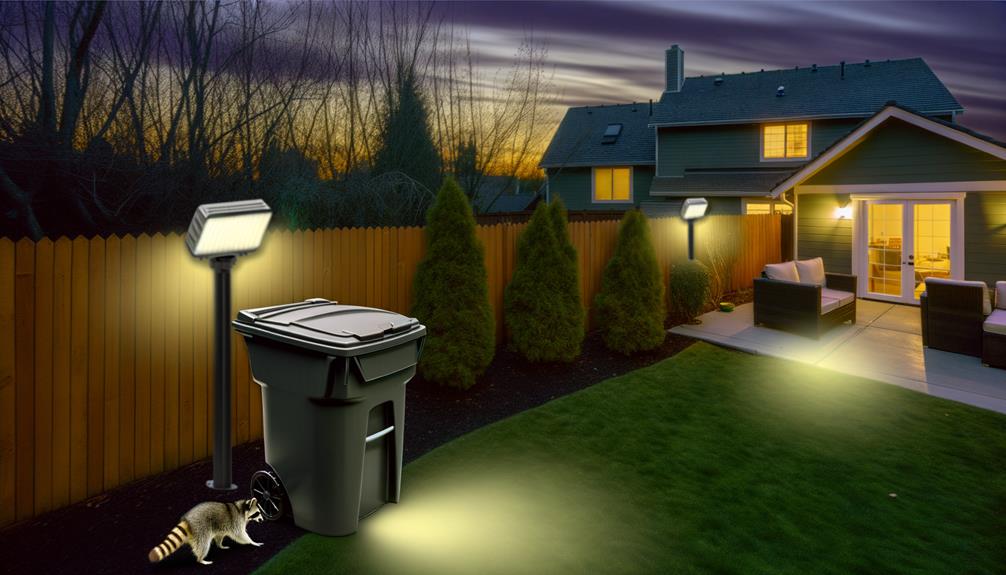5 Effective Tips to Keep Raccoons Away from Your Home
To keep raccoons away, start with secure trash management by using sturdy, tightly sealed containers and storing them in locked areas. Eliminate all accessible food sources by storing pet food indoors, managing bird feeders, and securing compost bins.
Use natural repellents like ammonia-soaked rags or cayenne pepper, and consistently reapply them. Seal all potential entry points with durable materials and maintain these defenses regularly.
Install proper fencing and consider ultrasonic devices for added deterrence. Live traps can also provide humane removal.
Regular yard maintenance and professional wildlife control can offer additional, effective insights and strategies.

Key Takeaways
- Use tightly sealed trash containers and store them in secure areas like locked sheds or garages.
- Eliminate food sources by storing pet food indoors and securing compost bins with tight lids.
- Apply natural repellents like ammonia-soaked rags, cayenne pepper, or predator urine around your property.
- Seal entry points with heavy-gauge metal mesh or steel wool to prevent raccoon access.
- Install proper fencing with mesh size less than 3 inches and consider electrified options for added security.
Secure Trash Cans
Securing trash cans is an essential step in deterring raccoons, as these nocturnal creatures are adept at scavenging easily accessible food sources. To effectively prevent raccoons from accessing trash, invest in sturdy, tightly sealed containers.
Metal or heavy-duty plastic cans with locking mechanisms are ideal choices, as they offer resistance to the persistent efforts of raccoons. Additionally, consider placing trash cans in a secure area, such as a locked shed or garage, especially overnight when raccoons are most active.
Regularly cleaning the exterior of the trash cans can also eliminate odors that attract raccoons. By adopting these measures, communities can notably reduce the likelihood of raccoon invasions, thereby promoting a cleaner and safer environment for all residents.
Eliminate Food Sources
Eliminating food sources around your property is crucial in preventing raccoons from being attracted to the area. Raccoons are opportunistic feeders, and any accessible food can entice them. Ensuring that pet food is stored indoors, bird feeders are managed properly, and compost bins are secured can make a significant difference. Additionally, fallen fruits from trees should be promptly collected, and outdoor grills must be cleaned thoroughly after each use.
| Food Source | Recommended Action |
|---|---|
| Pet Food | Store indoors or in sealed containers |
| Bird Feeders | Use raccoon-proof feeders |
| Compost Bins | Secure with tight lids |
| Fallen Fruit | Collect and dispose regularly |
| Outdoor Grills | Clean after each use |
Install Motion-Activated Lights
Installing motion-triggered lights can be an effective deterrent for raccoons, capitalizing on their natural aversion to sudden changes in their environment. These lights, activated by motion, startle raccoons, prompting them to seek shelter elsewhere.
When selecting motion-triggered lights, consider LED options for their energy efficiency and longevity. Position the lights strategically around vulnerable areas such as garbage bins, gardens, and entry points to homes. Mount the devices at a height that minimizes false activations caused by smaller animals.
Regularly inspect and maintain the lights to ensure peak performance. By incorporating this method, you not only protect your property but also contribute to a safer, raccoon-free community. This humane approach aligns with a commitment to responsibly managing wildlife interactions.
Use Natural Repellents
Employing natural repellents offers an eco-friendly and humane method to deter raccoons from invading your property. These repellents utilize scents that raccoons find repugnant, such as ammonia, hot pepper, or predator urine.
Ammonia-soaked rags simulating the smell of urine can be strategically placed around entry points. Sprinkling a mixture of cayenne pepper and water along the perimeter can irritate raccoons' sensitive noses, encouraging them to seek more comfortable environments.
Additionally, commercially available predator urine, such as that from coyotes, can create an illusion of a threatening presence. Consistently reapplying these natural substances will maximize their efficacy. This approach aligns with sustainable practices while ensuring the safety and well-being of both raccoons and residents.
Seal Entry Points
Effectively preventing raccoons from infiltrating your property begins with a thorough inspection of potential entryways.
Utilizing durable materials to seal these points guarantees long-term protection against these persistent creatures.
Additionally, implementing a regular maintenance routine will help identify and address any new vulnerabilities promptly.
Inspect Potential Entryways
To prevent raccoons from infiltrating your home, it is essential to meticulously inspect and seal all potential entry points where these clever animals might gain access. Begin by examining areas such as attics, basements, and crawl spaces. Pay close attention to vents, chimneys, and gaps in the foundation, as these are common entryways for raccoons.
Below is a table highlighting key areas to inspect:
| Area to Inspect | Common Issues Found |
|---|---|
| Attics | Damaged vents, loose shingles |
| Basements | Cracks in foundation |
| Chimneys | Uncovered flues |
Ensuring a thorough inspection and addressing these vulnerabilities will notably reduce the likelihood of raccoons entering your home. Your diligence in this matter will provide a safer, more secure environment for those you serve.
Use Durable Materials
After identifying potential entry points, the next step is to seal them using durable materials to guarantee raccoons cannot breach these barriers. Opt for heavy-gauge metal mesh, steel wool, or hardware cloth with a mesh size smaller than half an inch to cover vents, chimneys, and gaps.
For larger openings, consider using sturdy materials like metal flashing or concrete to secure longevity and resistance. Make sure all materials are securely fastened and check for weak spots that raccoons could exploit.
Additionally, inspecting and reinforcing the foundation, roof, and eaves with durable materials will further prevent raccoon access. By using these resilient materials, you create a robust defense that not only deters raccoons but also preserves the structural integrity of your property.
Regular Maintenance Routine
Establishing a regular maintenance routine is crucial to make certain that all entry points remain sealed and impervious to raccoon intrusion. Regular inspections should be carried out to identify potential vulnerabilities, such as gaps, holes, or weakened structures. It is advisable to use durable materials like metal mesh or heavy-duty wood to seal these entry points. Additionally, make sure that vents, chimneys, and other openings are adequately covered with raccoon-proof caps.
| Maintenance Task | Frequency |
|---|---|
| Inspect Attic and Roof | Monthly |
| Check Foundation and Doors | Quarterly |
| Secure Vents and Chimneys | Semi-Annually |
Trim Trees and Shrubs
Regularly maintaining trimmed trees and shrubs is essential in deterring raccoons from accessing your property. By ensuring that tree branches are at least six to eight feet away from rooftops, you eliminate potential pathways for raccoons to reach your home.
Additionally, keeping shrubbery well-trimmed reduces hidden areas where raccoons might seek shelter or forage. Overgrown vegetation provides not just cover but also potential food sources via insects or fruits.
Implementing a routine trimming schedule demonstrates vigilance and care for your property, which in turn protects the homes and properties of those you serve. Consistent maintenance not only enhances the aesthetic appeal of your landscape but also serves as a proactive measure against wildlife encroachment.
Install Fencing
Installing fencing is an effective strategy to keep raccoons at bay, provided that the fence material and height are carefully selected.
Opt for durable materials such as metal mesh or electrified fencing to withstand raccoon attempts at breaching.
Additionally, make sure the fence is at least four feet high and extends underground to prevent raccoons from climbing over or burrowing underneath.
Choose Appropriate Fence Material
Selecting the right fence material is essential to effectively deter raccoons from entering your property. Opt for materials that are robust and resilient, such as galvanized steel or heavy-duty mesh. These materials are difficult for raccoons to chew through or manipulate.
Additionally, the mesh size should be small enough to prevent raccoons from squeezing through, ideally less than 3 inches. For added security, consider using electrified fencing, which provides a mild, non-lethal shock to discourage climbing.
It's also advisable to use materials treated to withstand various weather conditions, ensuring longevity. By choosing the appropriate fence material, you can create a formidable barrier that protects your property and supports a raccoon-free environment.
Ensure Proper Fence Height
After selecting the appropriate fence material, the next critical step in deterring raccoons is making sure the fence height is adequate to prevent these agile climbers from gaining access to your property. Experts recommend a minimum height of 4 feet, but ideally, 6 feet to effectively thwart raccoons.
Additionally, consider installing a fence with an outward-facing angle at the top, extending about 12 inches. This design makes it significantly more challenging for raccoons to climb over. For enhanced security, electrified wires can be strategically placed along the top of the fence.
Regularly inspect and maintain the fence to guarantee its integrity, as raccoons are adept at finding weak spots. A well-constructed, sufficiently high fence is crucial in safeguarding your property.
Use Ultrasonic Devices
Ultrasonic devices offer a humane and technologically advanced solution for deterring raccoons from invading your property. These devices emit high-frequency sound waves, which are inaudible to humans but unpleasant for raccoons, encouraging them to stay away.
Strategically placing these devices around your property creates an inhospitable environment for raccoons without causing them harm. Ultrasonic repellents are typically solar-powered and weather-resistant, ensuring continuous operation regardless of environmental conditions.
When selecting an ultrasonic device, look for models with adjustable frequency settings to prevent animals from becoming accustomed to a single frequency. Regularly monitor the device's functionality and placement to maintain its efficacy.
This method aligns with an ethical approach to wildlife control, safeguarding both your property and the animals.
Employ Live Traps
Employing live traps is a humane and effective method for capturing and relocating raccoons that have invaded your property. These traps are designed to capture the animal without causing harm, allowing you to relocate them safely.
When using live traps, consider the following:
- Selection of Trap Size: Make sure the trap is large enough to comfortably accommodate a raccoon, typically around 32 to 42 inches in length.
- Bait Selection: Use attractive baits such as marshmallows, fruit, or canned tuna to entice the raccoon into the trap.
- Placement: Position the trap along known raccoon paths or near damage sites to increase the likelihood of capture.
Clean Up Yard Debris
Maintaining a clean yard is important in deterring raccoons. It reduces the availability of food sources and hiding spots. Removing any accessible food, securing trash bins with tight-fitting lids, and trimming overgrown vegetation can greatly diminish the appeal of your property to these nocturnal creatures.
An orderly yard not only enhances its aesthetic but also acts as a proactive measure against raccoon infestation.
Remove Food Sources
Eliminating potential food sources by thoroughly cleaning up yard debris is an essential step in preventing raccoons from being drawn to your property. Raccoons are opportunistic feeders, often scavenging through debris for hidden food. To effectively deter them, make sure your yard is meticulously maintained.
Cut back overgrown vegetation and remove fallen fruits or nuts. Additionally, clear away any compost piles or bird feeders that might offer easy meals for these nocturnal visitors.
Key actions to take include:
- Regularly rake and dispose of fallen leaves and twigs: This reduces hiding spots and makes your yard less appealing.
- Harvest garden produce promptly: Prevent raccoons from indulging in fruits and vegetables.
- Seal pet food containers tightly: Avoid leaving any food outdoors overnight.
Secure Trash Bins
Securing trash bins with tight-fitting lids is essential to prevent raccoons from accessing and scattering waste materials throughout your yard. These nocturnal creatures are adept at opening unsecured bins, leading to unsightly messes and potential health hazards.
Employing metal or heavy-duty plastic bins with locking mechanisms can effectively deter raccoons. Additionally, placing bins in a secured area or using bungee cords can provide extra protection. Regularly cleaning the bins minimizes odors that attract raccoons.
Beyond securing trash bins, promptly removing yard debris such as fallen fruits, leaves, and branches reduces the availability of shelter and food sources for raccoons. Maintaining a clean, debris-free yard is a proactive measure to safeguard your property and serve your community by promoting a healthier environment.
Trim Overgrown Vegetation
In addition to managing waste, trimming overgrown vegetation and cleaning up yard debris are pivotal steps in deterring raccoons from making your property their habitat.
Overgrown plants and accumulated yard debris provide raccoons with hiding places and nesting areas. To effectively discourage raccoons, make sure your yard is well-maintained by:
- Regularly trimming bushes and trees: This reduces potential nesting sites and limits raccoons' access to your home.
- Removing fallen leaves and branches: Yard debris can harbor insects and other small animals that attract raccoons.
- Keeping lawn grass short: Short grass not only improves visibility but also decreases the likelihood of raccoons feeling safe on your property.
Partner With Wildlife Control
Partnering with professional wildlife control services can provide an effective and thorough solution for managing raccoon intrusions on your property. These experts possess the necessary knowledge and tools to address raccoon issues without causing harm to the animals. They conduct detailed inspections to identify entry points and attractants, guaranteeing a holistic approach to prevention.
By implementing exclusion techniques such as sealing gaps and installing raccoon-proof barriers, wildlife control professionals mitigate recurrence. Additionally, they offer valuable guidance on maintaining a raccoon-free environment, emphasizing proper waste management and habitat modification.
Engaging these services ensures a balanced approach, prioritizing both human safety and wildlife preservation, aligning with the goals of those committed to serving their communities and protecting natural ecosystems.
Conclusion
Securing trash cans and eliminating food sources serve as the first line of defense, much like a castle's fortified walls.
Motion-activated lights act as vigilant sentinels, while natural repellents and sealed entry points resemble a moat deterring invaders.
Ultrasonic devices and live traps function as strategic outposts, maintaining order.
Cleaning yard debris guarantees no hidden threats linger, and partnering with wildlife control symbolizes a unified front.
Together, these measures create an impregnable fortress against raccoon invasions.






